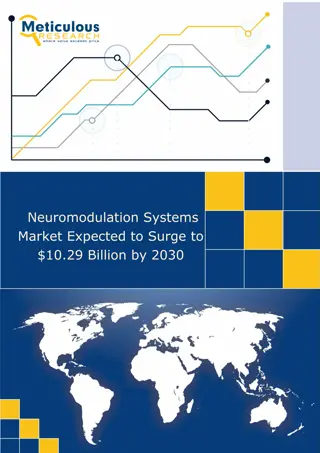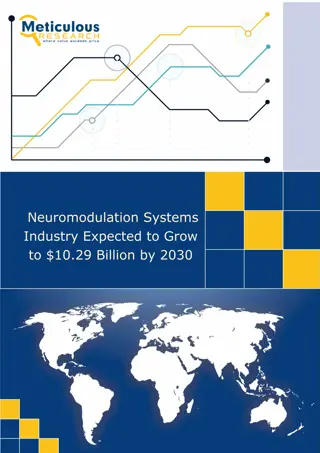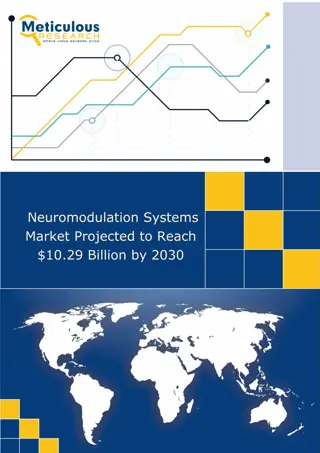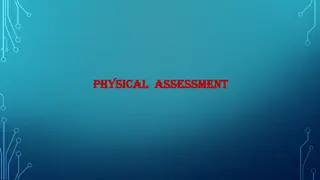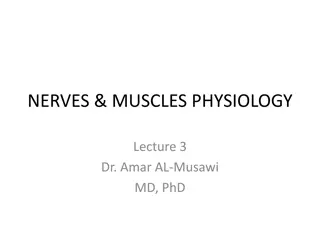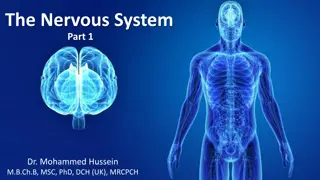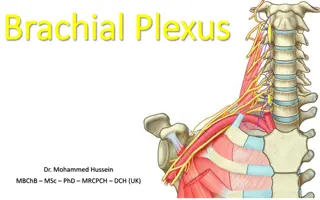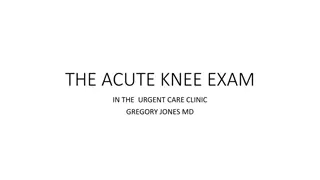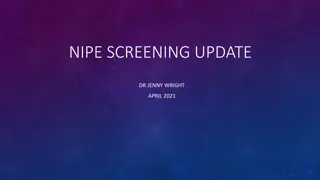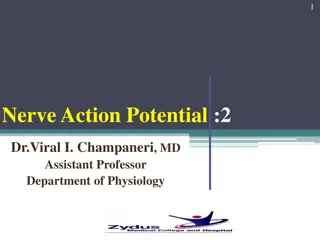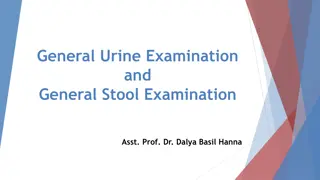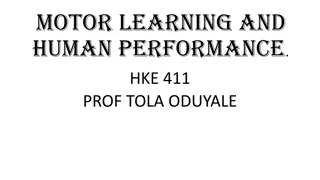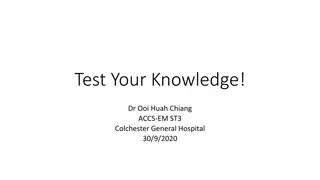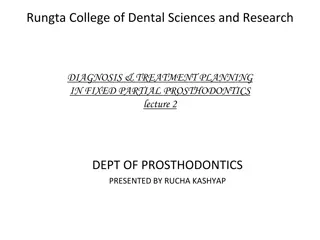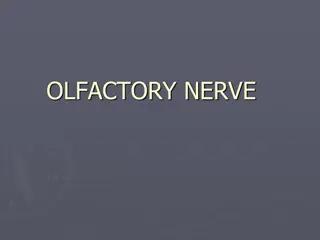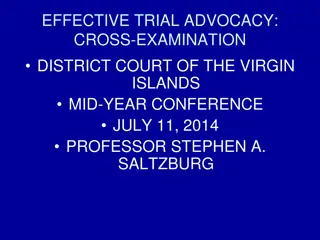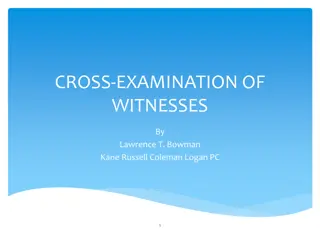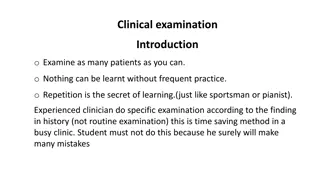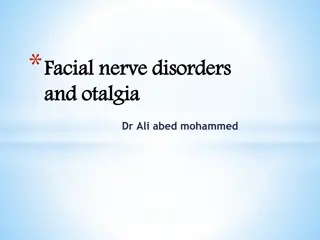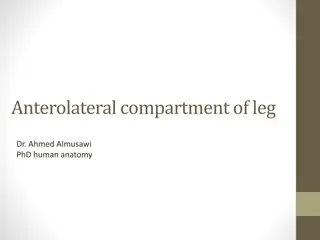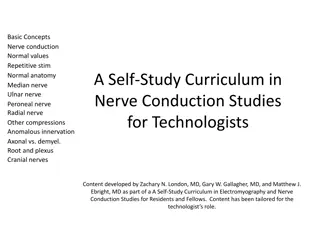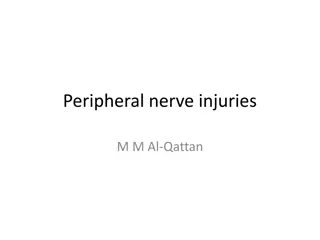The Popliteal Fossa
The popliteal fossa, a shallow depression at the back of the knee joint that serves as a passage for main vessels and nerves. Discover its boundaries, roof, floor, and contents like the popliteal artery, popliteal vein, tibial nerve, and common fibular nerve.
3 views • 9 slides
Autonomous Software Excellence: Transforming Assessments with vmedulife
Effortlessly manage examination data for autonomous institutes with vmedulife\u2019s Autonomous Software module. From seamless examination scheduling to question paper generation, student enrollment, and efficient handling of pre and post-examination tasks, our system streamlines the entire process
3 views • 5 slides
SMALL FIBRE
Small fiber neuropathy involves thin and unmyelinated nerve fibers, leading to various sensory disturbances. The Erlanger and Gasser classification details the different types of nerve fibers involved. Symptoms include burning, tingling, and numbness, often presenting in a stocking-glove pattern. Di
4 views • 53 slides
Nerve and muscle physiology
The lecture delves into the intricate structure of nerves, highlighting the morphology of nerve fibers and the process of myelination. It explores the classification of nerve fibers, emphasizing the role of dendrites, axons, and synaptic functions in the nervous system. The significance of Schwann c
4 views • 29 slides
Neuromodulation Systems Market Expected to Surge to $10.29 Billion by 2030
Meticulous Research\u00ae\u2014a leading global market research company, published a research report titled\n \u2018Neuromodulation Systems Market by Type (Spinal Cord, Sacral Nerve, Vagus Nerve, Deep Brain Stimulation),\n Application (Parkinson's Disease, Tremor, Depression, Epilepsy, Gastroparesis
0 views • 3 slides
Neuromodulation Systems Industry Expected to Grow to $10.29 Billion by 2030
Meticulous Research\u00ae\u2014a leading global market research company, published a research report titled\n \u2018Neuromodulation Systems Market by Type (Spinal Cord, Sacral Nerve, Vagus Nerve, Deep Brain Stimulation),\n Application (Parkinson's Disease, Tremor, Depression, Epilepsy, Gastroparesis
0 views • 3 slides
Neuromodulation Systems Market Projected to Reach $10.29 Billion by 2030
Meticulous Research\u00ae\u2014a leading global market research company, published a research report titled \n\u2018Neuromodulation Systems Market by Type (Spinal Cord, Sacral Nerve, Vagus Nerve, Deep Brain Stimulation), \nApplication (Parkinson's Disease, Tremor, Depression, Epilepsy, Gastroparesis
1 views • 3 slides
Waterbeach Community Forum Updates and Examination Progress
The Waterbeach Community Forum on Wednesday, March 20, 2024, discussed important topics such as the ongoing examination of the CWWTPRP, upcoming hearings, and local diversions during construction. The examination process, including hearings on visual impacts, traffic, and access restrictions, involv
0 views • 6 slides
Understanding Physical Examination: Importance and Purpose
Physical examination plays a crucial role in assessing a patient's physical and mental well-being, detecting diseases early, and establishing a good doctor-patient relationship. It involves systematically collecting objective information through examination techniques. The examination helps identify
2 views • 34 slides
Veterinary Clinical Examination Techniques and Procedures
Learn about the essential veterinary clinical examination techniques including distant examination (inspection), physical examination (palpation, percussion), auscultation, and more. Understand the importance of visual observation, hands-on assessment, and listening to internal organ sounds in diagn
5 views • 24 slides
Academic Department Management Workshop on Examination Processes and Irregularities
The workshop organized by Makerere University's College of Humanities and Social Sciences focuses on the operation of department examination processes, handling examination malpractices, and ensuring academic integrity. It covers themes such as student orientation, liaison, department operations, an
0 views • 10 slides
Objective Structured Clinical Examination (OSCE): A Modern Approach to Assessing Clinical Competence
The Objective Structured Clinical Examination (OSCE) is a modern examination method widely used in the field of health science to evaluate clinical skill performance. It involves stations where medical students interact with simulated patients to demonstrate competencies such as history taking, phys
1 views • 40 slides
Comprehensive Guide to Ophthalmic Examination in Veterinary Medicine
A detailed guide on the ophthalmic examination of animals led by Dr. Bipin Kumar, Assistant Professor at the Bihar Veterinary College. The examination covers history taking, general physical examination, evaluation of vision, pupil function, eyelid function, adnexal and anterior segment examination,
1 views • 9 slides
Understanding Nerves and Muscles: Physiology Insights by Dr. Amar AL-Musawi MD, PhD
Explore the intricate world of nerve fiber morphology, myelination, and classification in this enlightening lecture by Dr. Amar AL-Musawi. Delve into the significance of myelination in enhancing nerve function and learn about factors affecting conduction velocity. Discover the role of glial cells in
0 views • 15 slides
Understanding the Basics of the Nervous System with Dr. Mohammed Hussein
Explore the fundamentals of the nervous system in Part 1 with Dr. Mohammed Hussein, covering nerve cells, cellular processes, types of neurons, nerve structure, blood vessels, grey matter, and afferent and efferent neurons. Gain insights into the key components that make up this intricate system.
0 views • 12 slides
Understanding the Brachial Plexus Anatomy and Function
The brachial plexus is a crucial network of nerves in the upper limb, formed by nerve fibers originating from C5 to T1 spinal levels. It plays a significant role in innervating the upper extremity muscles and providing sensory feedback. The plexus is categorized into roots, trunks, divisions, cords,
0 views • 55 slides
Mechanism of General Anaesthesia Theories: Lipid Solubility, Surface Tension, Microcrystal, Protein Binding
Mechanism of general anaesthesia involves theories focusing on the interaction of anaesthetics with cell membrane components like lipids and proteins. The Lipid Solubility theory emphasizes the importance of an anaesthetic's affinity and solubility in nerve cell membranes, while the Surface Tension
1 views • 10 slides
Comprehensive Guide to Acute Knee Examination in Urgent Care
This detailed guide covers the essential components of the acute knee exam conducted in an urgent care setting by Dr. Gregory Jones, including chief complaints, anatomy, examination techniques, ligament assessments, practical aspects, and more. The examination process involves assessing functional l
1 views • 27 slides
Newborn Infant Physical Examination (NIPE) and Neonatal Checks Overview
Essential information on the NIPE screening update, neonatal checks, learning outcomes, eye examination, heart and CVS examination, and hips assessment for newborns. This content emphasizes early identification of abnormalities, top-to-toe examination, referral guidelines, and critical assessments t
0 views • 11 slides
Examination of Witnesses under Indian Evidence Act, 1872
Chapter X of Part III of the Indian Evidence Act, 1872, outlines the process of examining witnesses, including the order of production and admissibility of evidence. Sections 135 to 141 delve into the rules governing the examination-in-chief, cross-examination, and re-examination of witnesses, empha
2 views • 8 slides
Understanding Nerve Action Potentials: Key Stages and Mechanisms
Explore the intricate process of nerve action potentials, including depolarization, overshoot variations, repolarization stages, and the role of ion levels. Delve into the details of how neurons generate and propagate electrical signals essential for communication in the nervous system.
1 views • 63 slides
Understanding General Urine Examination and Stool Examination
General urine examination involves analyzing the color, clarity, and chemical composition of urine, providing insights into various health conditions and potential issues. It helps in detecting metabolic disorders, kidney diseases, and drug abuse. Additionally, the general stool examination is essen
0 views • 37 slides
Leprosy Nerve Examination by Dr. N. K. Kansal
This informative content provides a detailed guide on leprosy nerve examination conducted by Dr. N. K. Kansal, an Associate Professor. It covers the procedure for palpation of a nerve, emphasizing correct patient positioning and gentle palpation techniques. The importance of comparing nerves on both
0 views • 16 slides
Understanding the Biological Basis of Human Motion and Motor Learning
In the biological basis of human motion, a series of electro-chemical-physical reactions occur at the neuromuscular junction, enabling nerve stimulation for muscle contraction. Nerve impulses for movement originate in the central nervous system or muscles, with acetylcholine transmitting impulses be
0 views • 13 slides
Understanding Facial Nerve Lesions: Clinical Scenarios and Anatomy Overview
A comprehensive exploration of facial nerve lesions through real-life clinical scenarios and detailed anatomical insights. Dive into cases involving trauma, fractures, and abscesses to understand the varied manifestations of these lesions. Learn about the functions of the facial nerve, its segments,
0 views • 22 slides
Comprehensive Approach to Fixed Partial Prosthodontics Diagnosis and Treatment Planning
This lecture covers the essentials of diagnosis and treatment planning in fixed partial prosthodontics, focusing on recording case history, intraoral examination, and formulating treatment plans. Topics include oral examination, assessment of teeth, occlusal examination, periodontal examination, and
0 views • 25 slides
Clinical Evaluation of Trigeminal Nerve Function
Sensory evaluation of trigeminal nerve function involves assessing exteroceptive sensations across its divisions, identifying sensory losses due to lesions, and distinguishing different types of lesions affecting sensation on the face. Motor evaluation focuses on the muscles of mastication to detect
0 views • 34 slides
Comprehensive Guide to Neurological Examination in Dogs and Cats
Neurological examination in dogs and cats is crucial for diagnosing nervous system disorders. This guide covers the recording of history, general and detailed clinical examinations, examination of CSF, radiographic examination, EEG, and brain biopsy. It includes assessing history, mental state, move
0 views • 20 slides
Comprehensive CNS Examination Guidelines by Dr. Kiran Nandeshwar
Detailed guidelines for performing a thorough examination of the central nervous system (CNS) covering general examination, higher function assessment, Glasgow Coma Scale, cranial nerves examination, and motor system evaluation. Includes visual aids for each aspect of the examination process.
0 views • 24 slides
Comprehensive Clinical Evaluation of Children with Cardiac Abnormalities
Initial clinical evaluation of a child with possible cardiac abnormalities includes history taking and physical examination. History should cover symptoms related to pulmonary and systemic venous congestion, cyanosis, cyanotic spells, palpitations, chest pain, and more. The general physical examinat
0 views • 65 slides
Customs Brokers Licensing Training Program: Entry and Examination Procedures
This presentation covers the essential aspects of entry and examination procedures for imported goods, detailing the responsibilities of importers, examination stations at customs airports, customs possession of delayed goods, special inspections, and cost implications. It emphasizes the legal requi
0 views • 15 slides
Exploring the Olfactory Nerve and Its Role in the Sense of Smell
The olfactory nerve, the first cranial nerve, plays a crucial role in our sense of smell. It is unique for its ability to regenerate, with basal cells facilitating this process. The olfactory system is responsible for detecting odors and is essential for various behaviors in mammals. This system con
0 views • 20 slides
Effective Trial Advocacy: Cross-Examination Strategies by Professor Stephen A. Saltzburg
Enhance your trial advocacy skills with effective cross-examination strategies discussed by Professor Stephen A. Saltzburg at the District Court of the Virgin Islands mid-year conference. Learn techniques such as eliciting favorable information, attacking witness credibility, and conducting multiple
0 views • 41 slides
Mastering Cross-Examination of Witnesses in Legal Settings
Delve into the art of cross-examination with insights from Lawrence T. Bowman and Kane Russell Coleman Logan PC. Explore the power of cross-examination in uncovering truth, the competitive nature of trials, and the distinction between discovery depositions and trial cross-examination. Learn how to e
0 views • 41 slides
Comprehensive Guide to Clinical Examination Techniques
Clinical examination is a crucial aspect of healthcare practice, requiring a balance of skill, practice, and attention to detail. This guide covers the importance of practice, setting up the examination environment, necessary equipment, different examination areas, special examinations, general asse
0 views • 14 slides
Understanding Facial Nerve Disorders: An Overview
Facial nerve disorders can lead to various symptoms such as facial paralysis and otalgia. This article covers the embryology, anatomy, and neuropathophysiology of the facial nerve. The development of the facial nerve complex occurs in the early stages of gestation, and abnormalities may be associate
0 views • 39 slides
Journey from Esotropia Resulting from Bilateral 6th Nerve Palsy in Infancy to Orthotropia
A detailed case study presented at the 9th Annual State Ophthalmological Conference showcases the successful management of esotropia resulting from bilateral 6th nerve palsy. The journey of a 30-year-old male patient from childhood inward eye deviation to achieving orthotropia post-surgical interven
0 views • 6 slides
Overview of Leg Compartments and Nerve Supply in Human Anatomy
This informative content provides detailed insights into the anterolateral compartment of the leg, facial compartments, muscles in the lateral compartment, nerve supply, anterior compartment of the leg, blood, and nerve supply, deep fibular nerve distribution, dorsum and dorsalis pedis artery. It di
0 views • 10 slides
Understanding Electrical Concepts in Nerve Conduction Studies
Exploring the fundamental electrical properties in nerve conduction studies, including charge, voltage, current, and impedance. Learn about normal values, anatomy, and anomalies in nerve function. This self-study curriculum is designed for technologists interested in electromyography and nerve condu
0 views • 73 slides
Overview of Peripheral Nerve Injuries and Brachial Plexus Injuries
Explore different types of peripheral nerve injuries including Erb's palsy, Klumpke palsy, isolated axillary nerve injury, and isolated musculocutaneous nerve injury. Learn about the anatomy, causes, motor and sensory exams, and management of these injuries. Understand the myotomes and dermatomes as
0 views • 19 slides




